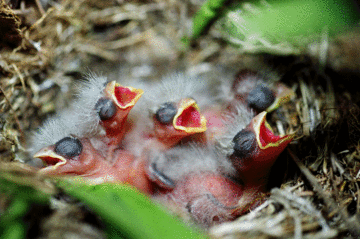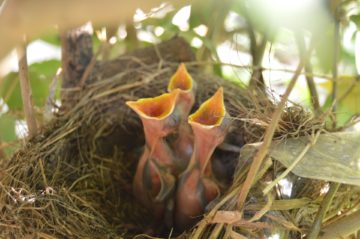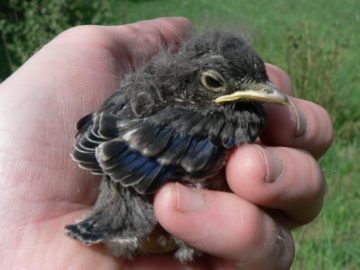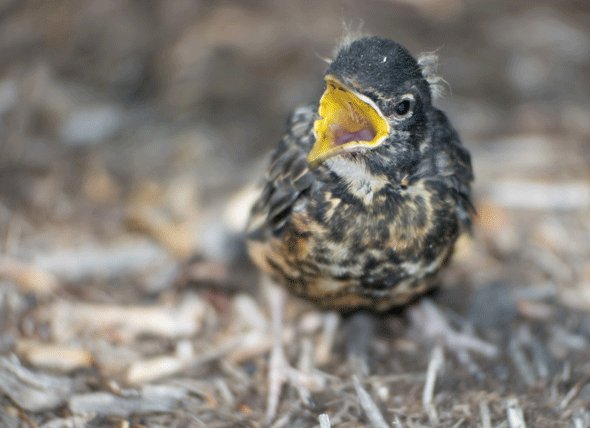Baby birds don’t always need help!
It’s that time of year. The leaves are finally green, the grass needs to be cut every few days, and baby animals are peeping their little heads out everywhere you look.
Here at the shelter, we receive requests to assist with wildlife multiple times on a daily basis. We run our volunteers ragged with trips to rehabbers, our staff members often head home with little fluffs of fur and feathers tucked safely  in carriers in their backseats, en route to organizations whose main mandate is to rehabilitate and release them.
in carriers in their backseats, en route to organizations whose main mandate is to rehabilitate and release them.
Our contract doesn’t cover wildlife, which means we are not always able to assist. We do what we can with what we’ve got, and we’re happy to say more often than not, we’re able to help. According to the Ministry of Natural Resources, “a person shall not keep live game wildlife or live specially protected wildlife in captivity except under the authority of a license and in accordance with the regulations.” Which means that we’re unable to care for a wild animal for any longer than necessary (24-hours) to transfer. That applies to individuals as well.
What should you do when you find wildlife that seems to be in danger though? Is there anything that can be done to save baby birds, raccoons, or bunnies? And how do you know if you should leave a wild animal or assist it?
General advice from the Ministry of Natural Resources is to leave the animal where you found it – removing it from the area may do more harm than good. Check back with the animal for one to two days. Often, one of the parents will return to either feed the babies or move them to a safer location. Do it from a distance though – animal parents are savvy and will stay hidden if they sense a threat. Keep cats, dogs, and children away from the babies and try to limit noise if possible.
If you see a baby animal somewhere unsafe like a roadway or a very busy area, feel free to give them a hand and move them to a quieter space, still within sight distance where you found them. This way, the parents have a chance at finding them.
Baby birds are especially adorable, and are often found on the ground in not-so-safe spots. This time of year, it’s mostly due to mom or dad teaching them life lessons. We see many fledglings come through the shelter doors, and most should be left where they were found.
A fledgling is approximately thirteen to fourteen days old. They’re fully-feathered, but still may not fly well. They hop around and can be quite quick. Though they may seem like they’ve been kicked out of the nest or abandoned by mom and dad, this is usually not the case. If you come upon a fledgling that’s in imminent danger, do your best to move it close but don’t attempt to put it back in the nest – it will probably jump right out again. Fledglings are out in the world to get a taste of real life. This apparently harsh style of parenting is actually instinctual. A predator has a much better chance of cleaning out a nest filled with loud, crying birds than chasing one down on the ground.
Nestlings and hatchings though, are a different story. Both are featherless, and both still require round-the-clock care from their parents.
The first thing someone should do if they find a nestling or hatching is to look around to see if a nest is close by. If the nest is there, put the bird back, otherwise mom will be looking everywhere.
Nestlings (the featherless baby birds) are sometimes blown out of their nest on a windy day or during a storm. And sometimes, the whole nest comes down. If you find a nestling, take the following steps:
1.Look around first to see if it fell from a nest that is still intact and in place. If the nest is still there, simply put the baby bird right back in it. Mom will not smell human scent on her baby and desert it. In fact, birds have quite a poor sense of smell.
2.If the nest has been blown down or has fallen to the ground, you’ll want to collect as much of the nest material from the ground as possible.
3.Next, get a plastic container the approximate size of the original nest or you can cut one to size. Put the nest material into the container and poke a few small holes in the bottom for drainage.
If there’s no nest material left, you can substitute either an old wash cloth or other type of clean, dry cloth, or some clean paper towels.
4.Nail your nest container high up in the tree closest to where you found the nestling, and gently place the baby bird back into the nest.
5.From a distance, watch your homemade nest very closely and wait for the mother bird’s return.
 Following these simple steps can help ensure all our little feathered friends have a good chance at survival, and an even better chance at leaving the nest.
Following these simple steps can help ensure all our little feathered friends have a good chance at survival, and an even better chance at leaving the nest.



